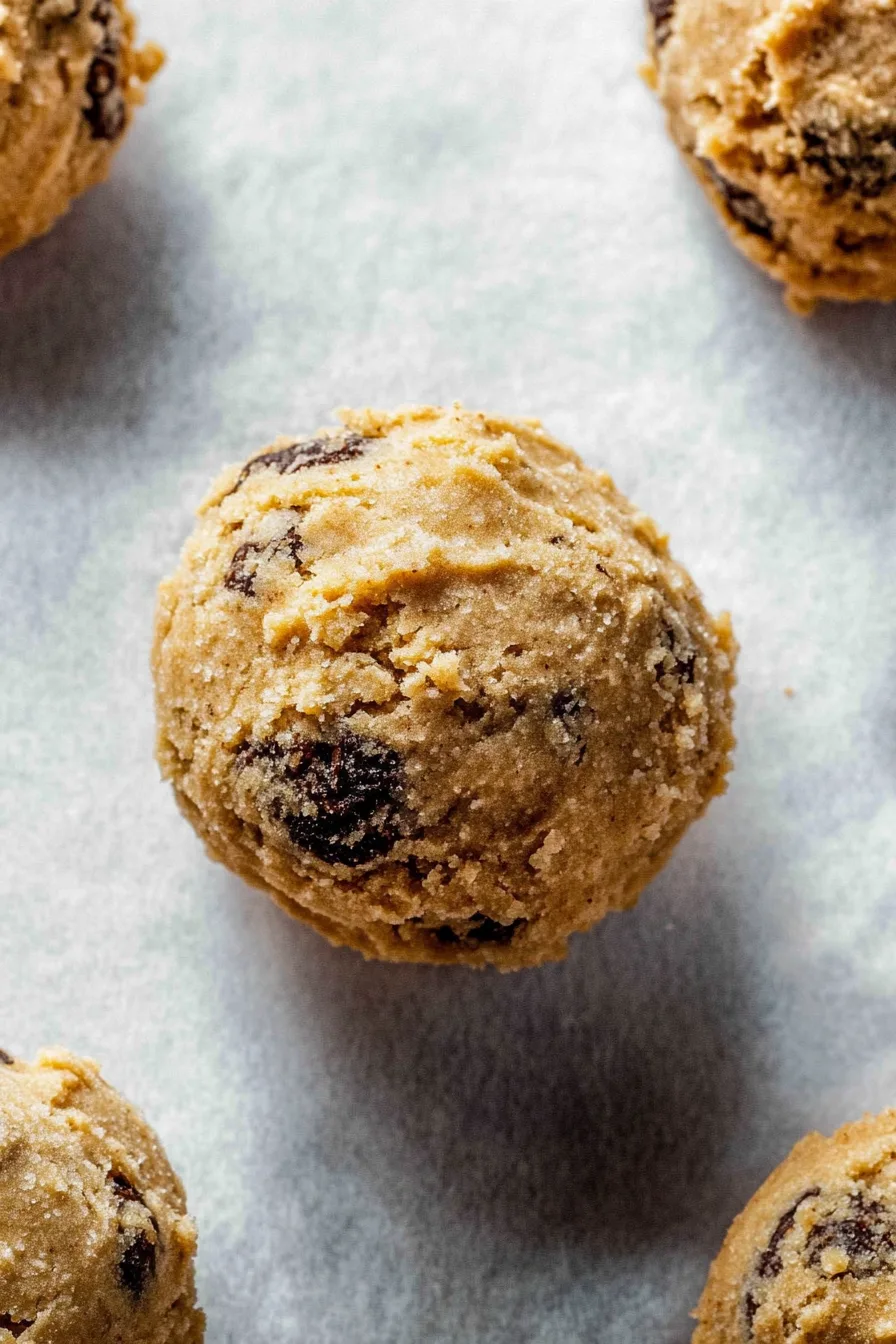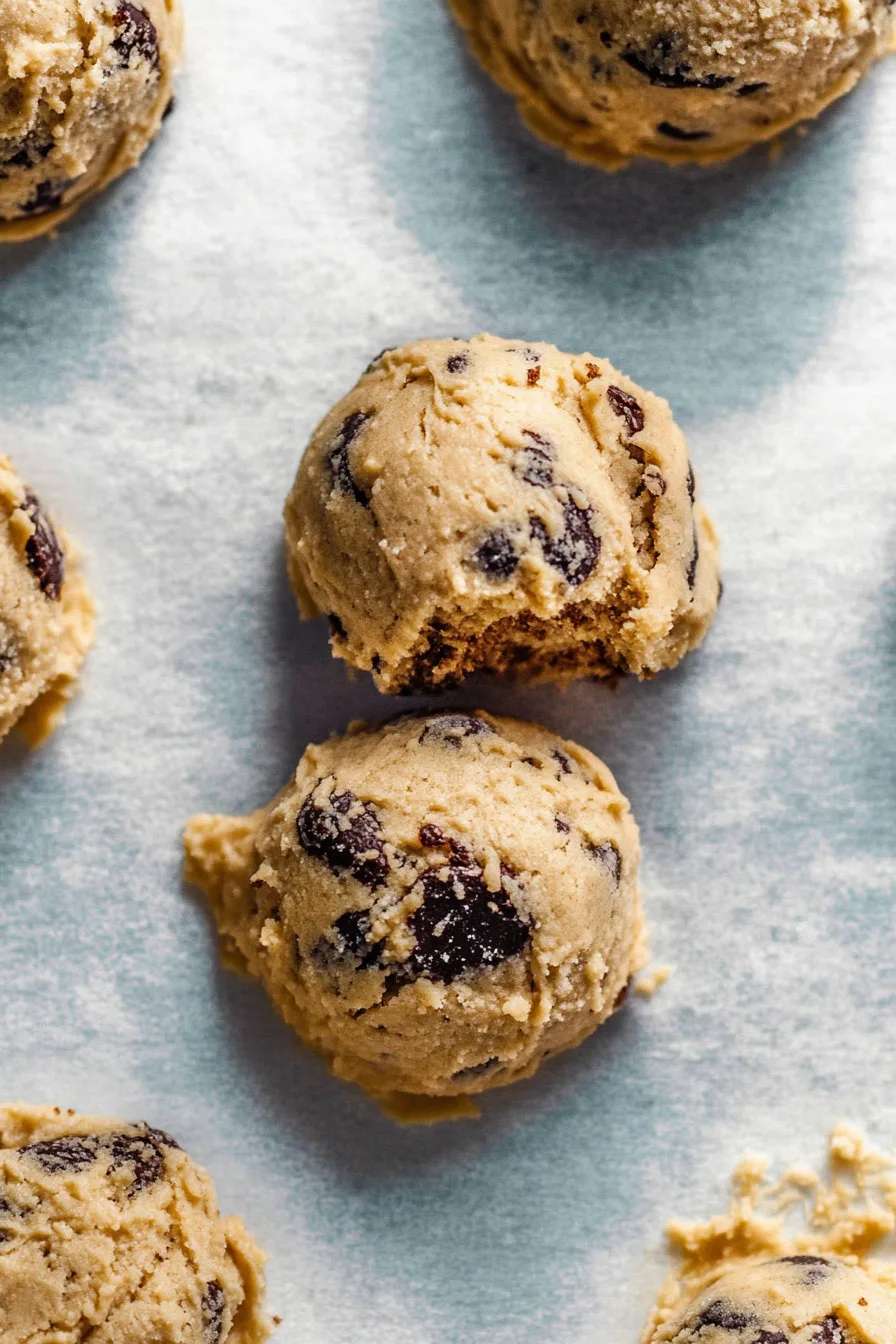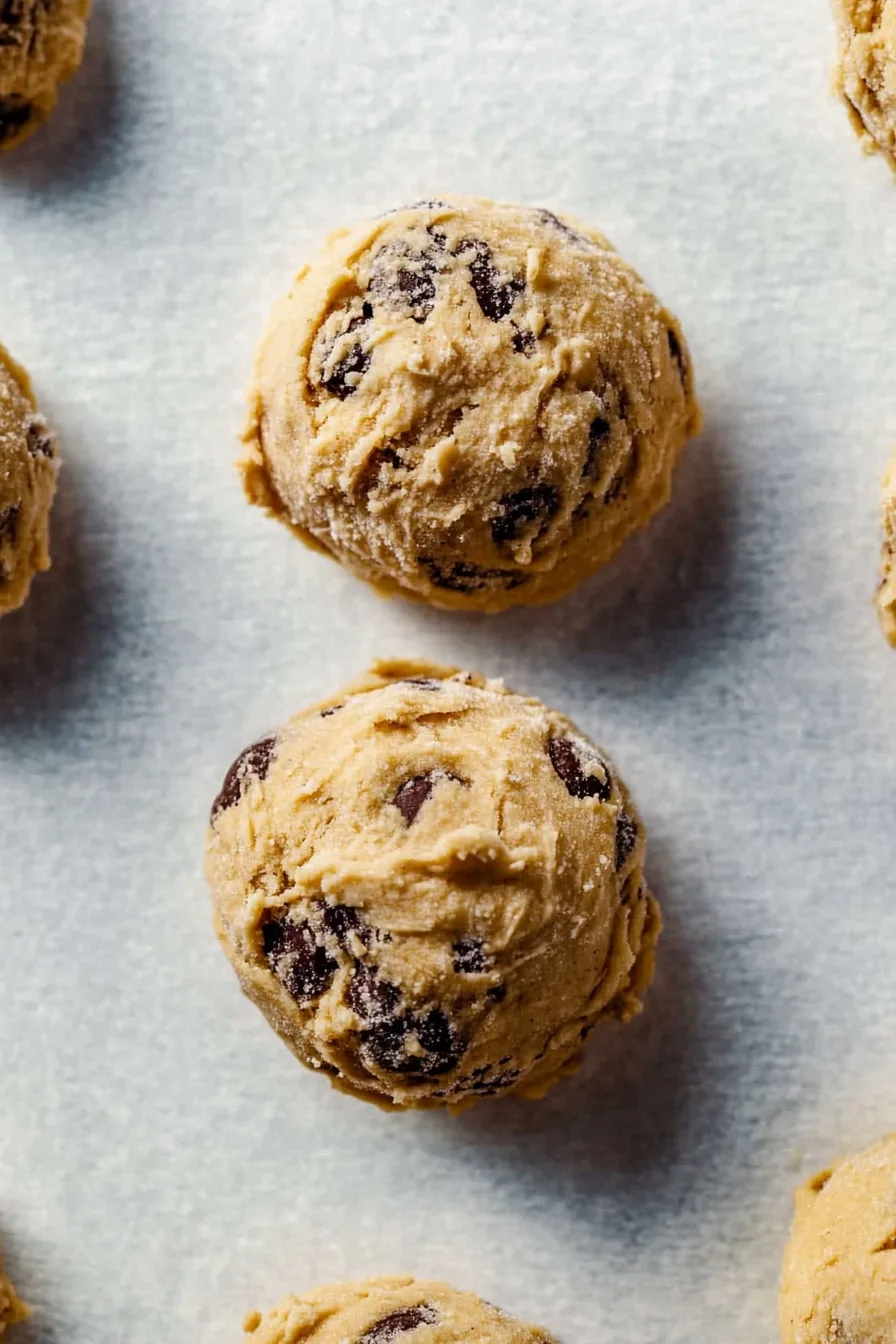Introduction to edible cookie dough
If you’re anything like me, sneaking a taste of cookie dough before baking is a guilty pleasure. Luckily, with this edible cookie dough recipe, you can indulge without worrying about raw eggs or flour. Made with heat-treated flour and free from eggs, it’s a safe, delicious treat that perfectly mimics traditional cookie dough’s creamy texture and chocolatey goodness. Whether you’re a busy parent, a student needing a sweet study break, or a food enthusiast seeking the latest trends, edible cookie dough is a simple and versatile option. Plus, it can be enjoyed straight from the bowl, making it a delightful and easy choice for everyone.
Benefits and Advantages of edible cookie dough
The unsurpassed ease of preparation sets edible cookie dough apart as a fantastic choice for dessert lovers. You can whip up a batch in minutes, eliminating the need for an oven and the risk associated with uncooked flour and eggs, which the CDC advises against consuming raw (CDC food safety). Additionally, this dough can cater to various dietary preferences, including vegan and gluten-free options. For those counting calories, modifications are simple—just swap ingredients where needed to align with your dietary goals. Its adaptability and rich flavor make it a favorite among busy professionals and health-conscious individuals alike.

Ingredients Overview
Essential Ingredients for Edible Cookie Dough
Creating a delicious batch of edible cookie dough requires just a handful of simple ingredients. Here’s a detailed list with measurements to guide you:
- 1 cup all-purpose flour (heat-treated)
- Purpose: Forms the base of the dough and gives it structure. Make sure to heat-treat to ensure safety.
- 1/2 cup unsalted butter, softened
- Purpose: Provides richness and a smooth texture.
- 1/3 cup brown sugar
- Purpose: Adds a depth of flavor and moistness to the dough.
- 1/4 cup granulated sugar
- Purpose: Balances sweetness and enhances texture.
- 2 teaspoons vanilla extract
- Purpose: Infuses the dough with a classic vanilla aroma and taste.
- 1/4 teaspoon salt
- Purpose: Enhances and balances the overall flavor.
- 2 tablespoons milk
- Purpose: Helps bind the ingredients and achieve the desired consistency.
- 1/2 cup chocolate chips
- Purpose: Provides a chocolatey burst of flavor in every bite.
Dietary Substitutions to Customize Your Edible Cookie Dough
Dietary restrictions or preferences shouldn’t prevent anyone from enjoying edible cookie dough. Consider the following substitutions:
| Ingredient | Substitution | Diet |
|---|---|---|
| All-purpose flour | Almond flour or gluten-free flour | Gluten-free |
| Unsalted butter | Coconut oil or vegan butter | Vegan |
| Milk | Almond milk or oat milk | Dairy-free |
| Chocolate chips | Carob chips or dairy-free chocolate chips | Dairy-free/Vegan |
How to Prepare the Perfect Edible Cookie Dough: Step-by-Step Guide
Making your own edible cookie dough is a straightforward process that anyone can follow. Here’s a detailed guide:
First Step: Heat-Treat the Flour
To start, heat-treat the flour to eliminate any potential bacteria. Spread it evenly on a baking sheet and bake in a preheated oven at 350°F for about 5-7 minutes. Alternatively, microwave the flour in 30-second intervals until it reaches 165°F. Ensure the flour is completely cool before using it.
Second Step: Create the Butter and Sugar Mixture
In a large mixing bowl, combine the softened unsalted butter, brown sugar, and granulated sugar. Use an electric mixer or a wooden spoon to cream these ingredients together until you achieve a light and fluffy consistency.
Third Step: Incorporate Vanilla and Salt
Next, add the vanilla extract and salt to the butter-sugar mixture. Mix well until the ingredients are fully integrated, and the mixture is smooth.
Fourth Step: Add the Heat-Treated Flour
Gradually add the cooled, heat-treated flour to the mixture. Blend at a low speed to ensure the flour is evenly incorporated without forming lumps.
Fifth Step: Mix in Milk for Desired Consistency
Slowly pour in the milk while mixing the dough. Adjust the quantity based on the texture; you want a firm but pliable dough.
Sixth Step: Fold in the Chocolate Chips
Finally, gently fold the chocolate chips into the dough using a spatula. Be careful not to over-mix to maintain the dough’s structure.
Your edible cookie dough is now ready to enjoy right away or you can store it for later. Its creamy texture and sweet flavor make it a versatile treat, perfect for snacking or as a base for other desserts.

Mastering Edible Cookie Dough: Advanced Tips and Variations
Once you’ve mastered the basic edible cookie dough recipe, it’s time to take your creations to the next level. With a few handy tips and creative variations, you can tailor this treat to suit any palate or occasion. Allow me to guide you through some advanced strategies and fun alternatives that will make your edible cookie dough experience truly extraordinary.
Flawless Techniques for Consistent Results
- Chill Before Serving: Allow the cookie dough to chill in the refrigerator for at least 30 minutes before serving. This simple step enhances the flavors and firms up the texture, delivering that classic cookie dough experience.
- Use Quality Ingredients: Since edible cookie dough involves minimal processing, using high-quality ingredients like real butter, pure vanilla extract, and premium chocolate chips will greatly impact the overall flavor.
- Heat-Treat Flour Correctly: Always heat-treat your flour adequately by baking it at 350°F for 5-7 minutes or microwaving in 30-second intervals until it reaches 165°F to eliminate any potential bacteria.
Exciting Variations to Try
- Peanut Butter Delight: Swap half the butter for smooth peanut butter. Sprinkle crushed peanuts or Reese’s pieces for added crunch and flavor.
- Nutella Swirl: Add a swirl of Nutella to your dough for an irresistible chocolate-hazelnut touch. Serve it as a topping for your favorite ice cream.
- Berries and Cream: Mix in dried cranberries or blueberries, and add a hint of lemon zest for a refreshing twist off your traditional cookie dough.
- Seasonal Spice: Infuse the dough with cinnamon, nutmeg, or pumpkin spice to align it with holiday flavors, perfect for festive gatherings or cozy evenings at home.
- M&M Crunch: For those who love colorful surprises, fold in M&M’s or other candy-coated chocolates.
By applying these tips and exploring these variations, your edible cookie dough can become a canvas for culinary experimentation, satisfying sweet tooth cravings across every spectrum.
How to Store Edible Cookie Dough: Best Practices
Proper storage of edible cookie dough not only maintains its freshness but also enhances its flavor over time. Understanding the right techniques for refrigeration, freezing, and even reheating can significantly prolong the delight of devouring this tasty treat.
Refrigeration Tips
- Short-Term Storage: If you plan to enjoy the cookie dough within a week, storing it in an airtight container in the refrigerator is ideal. This keeps it fresh and ready for consumption at any time.
- Best Containers: Use glass containers or heavy-duty plastic with a tight seal. This helps prevent unwanted odors from seeping in and maintains the dough’s moisture.
Freezing Techniques
- Long-Term Storage: For a future indulgence, freeze the dough in portion-sized scoops. Place the scoops on a baking sheet to freeze, then transfer them to a freezer-safe bag or container.
- Label Appropriately: Clearly label the container with the date of preparation to keep track of how long it has been stored. Ideally, enjoy within 2-3 months for the best flavor.
- Defrosting: When you’re ready to eat, move desired portions to the refrigerator to thaw overnight. For a quick fix, you might also defrost at room temperature for an hour.
Reheating If Needed
- Gentle Warm-Up: If you prefer warm cookie dough, gently reheat in the microwave for short bursts, around 10-15 seconds, keeping an eye on the texture so it doesn’t become too soft.
- Versatile Use: Warm cookie dough works splendidly as a topping over desserts like ice cream or cakes, adding an extra dimension of flavor.
By following these best practices, you ensure that each scoop of edible cookie dough retains its delicious essence and safety, from the moment it’s mixed until its very last bite. For further safe consumption tips, check out these CDC guidelines on safe edible cookie dough practices.

Nutritional Value of edible cookie dough
When it comes to indulging in treats like edible cookie dough, knowing the nutritional content can help you make informed choices about your diet. Edible cookie dough is known for its sweet, creamy texture and satisfying taste, but it’s important to balance these delightful sensory experiences with an awareness of what you’re consuming.
Caloric Content and Macronutrients
- Calories: A typical serving of edible cookie dough, about 1/4 cup or approximately 60 grams, contains around 200-250 calories. It’s a treat best enjoyed in moderation.
- Fat: Each serving contains around 12-15 grams of fat, primarily from the butter or plant-based alternatives used in the recipe. It’s important to note that using vegan alternatives can adjust these numbers slightly.
- Protein: You’ll find approximately 2-4 grams of protein per serving, depending on the ingredients and any additions you choose, like nuts or seeds.
- Carbohydrates: With around 28-32 grams of carbs per serving, edible cookie dough provides a quick source of energy, perfect for an indulgent snack.
- Sodium: While the addition of salt enhances the dough’s flavor, too much sodium is not ideal. Expect about 150-200 milligrams per serving.
Vitamins and Minerals
Though primarily a sweet treat, edible cookie dough can provide small quantities of essential nutrients:
- Calcium and Iron: Most doughs contain small amounts of calcium and iron, primarily coming from flour and any added milk or fortified alternatives.
- Sugar Content: With around 16-20 grams of sugar, it’s essential to consider this if you’re watching your sugar intake or have dietary restrictions.
For those who need to monitor their nutritional intake more closely, adapting recipes using gluten-free flour or sugar substitutes can offer lower-calorie or diabetic-friendly options. For a more extensive analysis of how this indulgent treat can fit into a balanced diet, check out this insightful article from simply nutritious, quick and delicious.
FAQs: Frequently Asked Questions About edible cookie dough
Is edible cookie dough safe to consume raw?
Yes, edible cookie dough is designed to be consumed raw. Unlike traditional cookie dough, it is made without raw eggs and uses heat-treated flour to mitigate the risk of foodborne illnesses such as salmonella and E. coli. For more on food safety, you can visit the CDC’s food safety page.
Can I bake edible cookie dough into cookies?
Edible cookie dough is meant to be enjoyed raw and doesn’t contain the necessary rising agents, like baking soda or baking powder, that are required for baking actual cookies. However, if you want a recipe designed for baking with similar flavor profiles, you can try options with slightly different ingredient ratios for successful baked cookies.
How should I store edible cookie dough to maintain freshness?
To keep your edible cookie dough fresh, store it in an airtight container in the refrigerator for up to one week. If you’d like to enjoy it over a more extended period, you can freeze it for up to three months. Allow it to thaw in the refrigerator before consuming.
Are there any ingredients in edible cookie dough that might be problematic for people with common allergies?
Common allergens in edible cookie dough include wheat (gluten), dairy, and sometimes nuts, depending on your chosen mix-ins. To accommodate these concerns, versions using gluten-free flour, dairy-free milk alternatives, and nut substitutes are widely available. Adjust the recipe to suit your dietary needs, ensuring you enjoy this delightful treat without worry.
For more delicious dessert ideas that cater to various dietary preferences, you might also enjoy Valentina’s Honey Glazed Roasted Brussels Sprouts.
Print
Edible Cookie Dough Recipe Easy
- Total Time: 17 minutes
Description
🍪 Indulge in the rich, buttery goodness of edible cookie dough—made safe to eat without raw eggs or untreated flour! 😍
🎉 Customize it with your favorite mix-ins and enjoy it straight from the bowl, as a topping, or chilled for later! 🍫
Ingredients
Flour (heat-treated)
Butter (softened)
Brown sugar
White sugar
Vanilla extract
Salt
Milk
Chocolate chips
Instructions
1. Preheat your oven to 350°F (175°C) to heat-treat the flour.
2. Spread the flour evenly on a baking sheet.
3. Bake the flour for 5-7 minutes or microwave it in 30-second intervals until it reaches 165°F (74°C).
4. Let the heat-treated flour cool completely before using.
5. In a mixing bowl, cream together the butter, brown sugar, and white sugar until smooth.
6. Add vanilla extract and a pinch of salt, then mix well.
7. Gradually mix in the cooled heat-treated flour.
8. Add milk a little at a time until the dough reaches your desired consistency.
9. Fold in chocolate chips or any other mix-ins like sprinkles or crushed Oreos.
10. Enjoy immediately or store in an airtight container in the refrigerator for up to a week.
Notes
Let your flour cool completely after heat-treating to avoid melting the butter when mixing.
For extra creaminess, use a combination of butter and a splash of heavy cream instead of just milk.
Store your edible cookie dough in an airtight container in the fridge to keep it fresh and delicious for up to a week.
- Prep Time: 10
- Cook Time: 7
- Category: Dessert
- Method: No Bake
- Cuisine: United States

